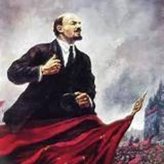
Lenin’s ‘New Economic Plan’
– Tactical Retreat, Not Confession of Error
In 1921, economic circumstances forced Vladimir Lenin to reverse course from ‘War Communism’ and partially loosen the state’s grip on the economy under the rubric of the ‘New Economic Plan’ (NEP). While this could be called a confession of error that communism does not work, it is more properly viewed as a tactical retreat, merely an expedient until the Soviet Union could safely once again assert control over all the means of production.
Whether confession of error or tactical retreat, the forced adoption of the NEP certainly shows that the standard of living is lower under communism than under capitalism, and that moving in the direction of economic freedom produces prosperity.
The story of the NEP began as the year 1920 was drawing to a close. After almost three years of fighting, the Bolshevik Red Army began to emerge as the victor in the Russian Civil War. The Bolsheviks’ success on the battlefield meant inheriting an economy crumbling from the devastating effects of World War I, the Bolshevik Revolution, and the Civil War. Moreover, their victory meant the Bolsheviks would have to start delivering on their utopian promises.
Bolshevik support was mostly came from urban workers. Yet the peasants, who were roughly 80 percent of the population, had to bear the brunt of the Bolshevik takeover. Leading to the death of between five to ten million people, the Great Russian Famine of 1921 stemmed not only from the unprecedented political and economic tumult of the previous several years, but was exacerbated by the Bolshevik’s economic program of War Communism. That program, what Lenin called ”state capitalism”, subordinated the entire Russian economy to support the Bolshevik military campaign.
During the Russian Civil War, all three main factions - Bolsheviks, Whites, and Anarchists – appropriated food for themselves and their supporters, often without paying farmers, and denied food to opposing factions. Lenin also confiscated basic food supplies and seed grain from farmers suspected of sabotage. Peasants and even former supporters of the Russian Revolution revolted.
The most significant rebellion against the Bolsheviks was the Kronstadt Rebellion of 1921. Kronstadt was a naval fortress, the base for the Russian Baltic Fleet whose troops had supported the Russian Revolution. However, the collapse of the economy and the emergence of widespread famine (disaster zones were declared in July 1921) led the sailors to feel betrayed by Bolshevik promises. As a result, they staged a revolt for almost two weeks – from the 7th to the 19th of March, 1921. A committee of sailors drafted The Petropavlovsk Resolution, named after one of the battleships. The resolution consisted of 15 demands which included greater economic and political freedom. Lenin viewed the uprising as a plot by the White Army. Other Communist organs ascribed equally nefarious origins to the revolt, including the involvement of foreign powers.
The Bolshevik government moved quickly to suppress the revolt. On March 17th, over 60,000 Bolshevik troops entered Kronstadt. Between one and two thousand sailors were killed or executed. Thousands of sailors successfully escaped to Finland. But for over a thousand other sailors unable to flee, forced labor camps were their fate. Although the Bolsheviks were able to put down the rebellion and suppress the labor strikes in nearby Petrograd, Lenin feared further challenges to the communist program and understood change in communist policy was needed. Against this backdrop, he introduced the New Economic Program (NEP) on March 21, 1921 to replace the disastrous War Communism program.
The growing calamity of the Great Famine posed a mortal threat to the Soviets. The death of several million and the ongoing starvation of millions more laid the conditions for more uprisings. To regenerate the economy, the NEP allowed for partial return to a mixed economy allowing private, individual ownership of small enterprises. Large industries, banks, and foreign trade remained, however, under state control. But the main focus was on reform of agricultural policies. Taxes on farmers and suppression of private land holdings that had been imposed under War Communism were now lifted. However, the Bolsheviks needed immediate relief before the NEP reforms could possibly alleviate the situation. Ironically, the very country representing the political and economic philosophy most hated by the Russian communist regime proved to be the Soviet Union’s greatest salvation.
In early 1919, the U.S. Congress had formed the American Relief Administration (ARA) headed by future president Herbert Hoover to provide relief to European countries devastated by the Great War. Alerted to the growing famine in Russia, the ARA offered assistance. Despite distrust of America’s motives and a wounded pride, the Soviets reluctantly accepted the aid which began to flow by the end of 1921. Over the next two years, the ARA spent $20 million while employing 300 Americans and 120,000 Russians to feed up to 10.5 million people a day. The ARA was also able to eradicate a typhoid epidemic stemming from the famine. Operations ceased by summer of 1923 when the Russian agricultural sector was strong enough to meet the country’s needs without assistance. (n.b. – The Soviets actually started exporting grain in 1922, despite prospects the famine afflicting its own people would continue, diverting foodstuffs in order to support the forced industrialization of the country under communist rule.)
Sources:
http://en.wikipedia.org/wiki/Russian_famine_of_1921
http://en.wikipedia.org/wiki/Kronstadt_rebellion
https://suite.io/michael-streich/2c5f2nv
http://en.wikipedia.org/wiki/New_Economic_Policy
http://en.wikipedia.org/wiki/American_Relief_Administration
http://news.stanford.edu/pr/2011/pr-famine-040411.html
Dr. Roman Serbyn, "The first man-made famine in Soviet Ukraine 1921-1923"